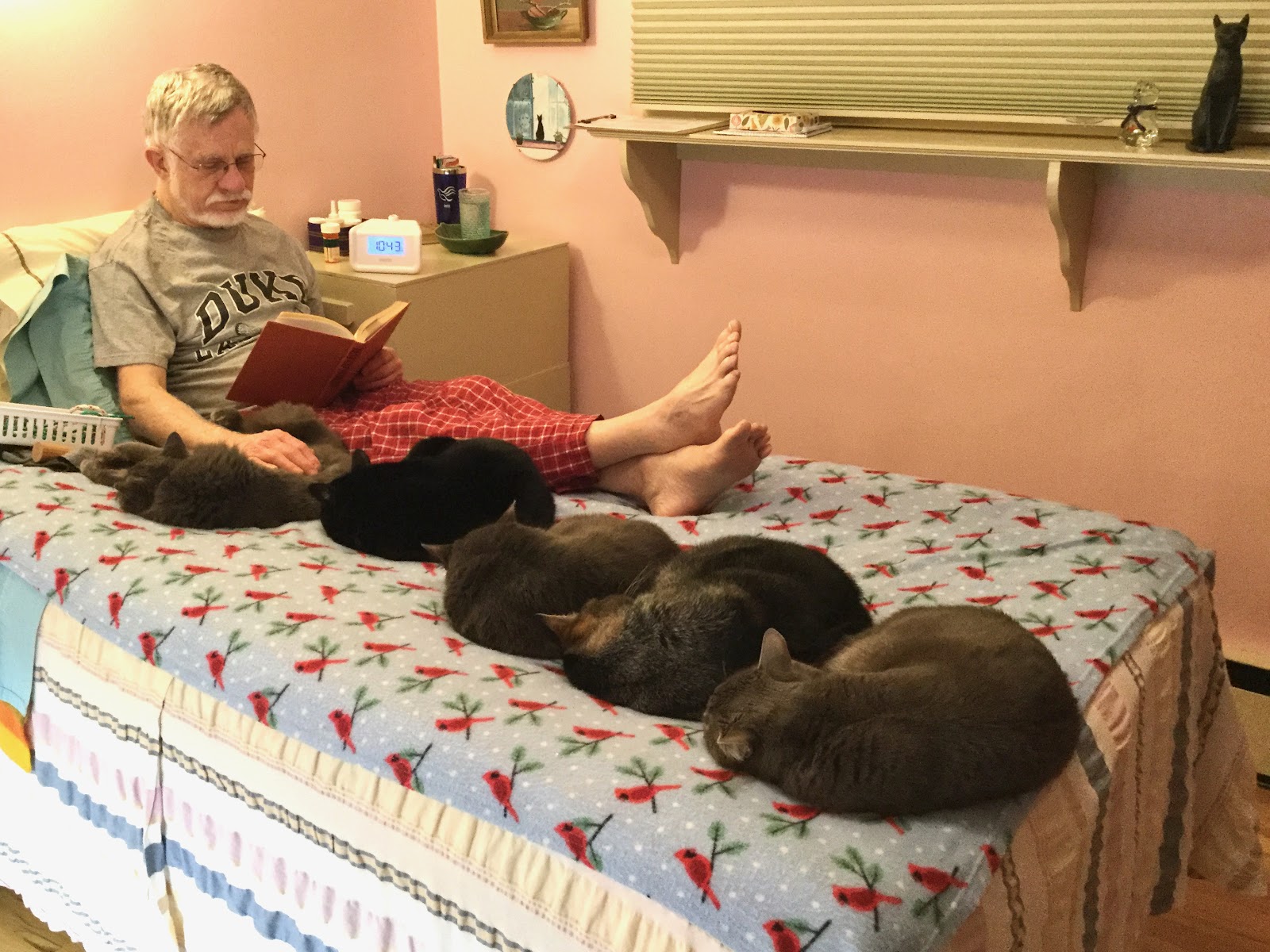I hate it when people ask why Peggy and I have five cats because I don’t want to make her look bad for denying me my right to have ten. I ask her, “When I’m dead, won’t you regret preventing me from spending our life savings on cats?” to which she replies, “I’ll just be glad that I don’t have even more litter boxes to clean.”
From 10:00 to 12:00 each night, I read in bed in the company of cats. Timid little Scully—the tuxedo cat second from left—took years to gather the courage to join me in bed and another year to move close enough for me to reach her. When the noise of wind, airplanes, car doors, heavy rain, and other things frighten Scully, I have the privilege of calming her fears.
The middle cat—seven-year-old Ollie—was abandoned while nursing. A cat rescuer bottle-fed him every two hours around the clock until he was old enough to eat, and then Peggy and I adopted him. Upon entering his new home, he immediately sought comfort from our fifteen-pound tabby, Brewsky. Brewsky hadn’t been near another cat since he came to us as a kitten five years earlier. He now looked at us as if to ask: “What in the hell am I supposed to with this thing?” After a tense moment, he bathed Ollie and then allowed him to “nurse.” Seven years later, Ollie is still nursing.
Ollie’s worst problem is that he vomits up everything he eats unless I—me, personally—give him special food in a special feeder. Two year’s ago, he started vomiting anyway, so I had to switch from three large meals a day to six small ones. He’s now back to three meals and chattering happily to himself the entire time he’s eating.
The cat at the end of the bed is five-year-old Sage. I usually get out of bed before Peggy does only to have him ignore me. When Peggy appears an hour later, Sage talks to her nonstop being cuddled. In the evenings, she holds him in her arms while dancing through the house. Late at night, they have extended conversations similar to the following. Peggy: Miaow. Sage: Meow? Peggy: No—miaow. Sage: Miaow? Peggy: Yes, miaow. Sage’s eyes open like saucers. Peggy laughs and roughs his fur. Sage says Miaow!!! Peggy responds Meow yourself, Mr. Man! Sage whispers in her ear. Peggy laughs. Peggy and Sage embrace.
Sage’s only flaw is that he becomes abusive when angry, and that too is directed at Peggy. Happily, he only becomes angry every other Friday when she clips his toenails, and only then when she does his back feet. She has to put her face near his while she works, and it is my job to keep his head pointed away from her face.
My hand is on three year old Harvey, who is a beautiful cat although he looks like a dirty dust mop in the photo. After lovingly parenting our other kittens, Brewksy walked right up to Harvey when Harvey arrived with the intention of bathing him. Despite being more fluff than cat, Harvey flattened his ears and hissed. He remains our only cat who has never deferred to The Patriarch of the Cat Side of the Family. He is usually on hand to welcome visitors, and to do what he can to assist repairmen. He also likes to steal my chair—or my place in bed—within seconds of me getting up to do something. When Peggy is brushing him, he will often hook a finger with his claws, hold it in his mouth, and go to sleep.
Prior to Brewsky’s arrival in 2010, I lived with dogs for 61-years, so I can confidently say that dogs and humans are hierarchists while—except for lions—the world’s 38 cat species live alone except when rearing their young. Yet...
Year in and year out, my five cats live within the same four walls. They share food, play together, tolerate foibles, bath one another, sleep with their bodies touching, settle arguments without bloodshed, and worry when one of their adopted siblings is upset. But if Felis silvestris catus is a solitary species, how are such things possible?
When we got Brewsky, I was as nervous as a new father who had never held a baby. Two days later, we took him to our vet—Sean Barrett—for his first check-up, and I was so impressed by Sean’s handling of him, that I resolved to also move slowly, touch gently, and speak softly. Brewsky and our other cats continued my education by teaching me to behave predictably; respect their independence; demonstrate joy in their existence; pay attention to what they tell me; abandon any hope of obedience or conformity; and avoid coercion whenever possible.
The love of a dog is a given; the love of a cat is a reward for good behavior. Yet I treated one of my cats in ways that surely would have caused the others to hate me.
Within months of his arrival, Brewsky grew from a cute kitten to a stubborn and willful adolescent who would look me dead in the eye while doing the very things I had just told him not to do. One night while Peggy was at work, I became so angry that I chased him thorough the house while yelling and slapping floors and overstuffed chairs with the flat side of a yardstick. I thought he would run under the couch, but he instead ran through the house in a circuit that ran from living room, to hall, to dining room, and back to living room. After a few laps, he stopped, turned, caught my eye, and rolled onto his back and asked for a belly rub. Thus began a nightly ritual in which I would play the role of a homicidal human; Brewsky would play the role of a terrified inferior; and then we would cuddle. Try as she might, Peggy couldn’t wrap her brain around the idea that what looked like a prelude to murder was actually a male bonding ritual worthy of drunken cowboys in a John Wayne movie.
“Dogs look up to us. Cats look down on us.” —Winston Churchill
Contrary to the feline snobbery suggested by Churchill (who was himself a cat lover), no cat is proud of belonging to one of the better families or ashamed of being from the wrong side of the tracks. While chimps, rats, wolves, humans, hyenas, and meerkats, are busy forming cliques, waging wars, installing dictators, and conspiring to mistreat others, cats are at quietly at home minding their own business.
People who consider cats cruel, selfish, unloving, fawning, and antisocial, project onto cats what their motives would be if they behaved similarly. According to animal behaviorists....
Asking for food, eating it, and then seeking privacy in which to bathe and nap only means that cats feel drowsy after they eat, and that they prefer to sleep in secluded places where they are safe from large predators. Likewise, they wash away food odors so that large predators can’t locate them.... Cat critics are also wrong in thinking that cats have repeatedly capture the same bird or mouse because they’re cruel, the truth being that they are honing their hunting skills. As for other errors...
While it is true some cats dominate other cats, such behavior is situational rather than ongoing, and—unless it results from close confinement—the roles of dominator and dominated reverse after a few months. Although males often fight over females, the queen (for that is what she is called) reserves the right to choose her mate, and she often chooses the loser.... Male cats have the reputation for being absentee fathers, yet some males love their own kittens and—as with Brewsky—the kittens of other males, and even the offspring of other species.
The following is from the Desiderata* poster that graced the walls of teenagers during the ‘60s and ‘70s:
“Go placidly amid the noise and the haste, and remember what peace there may be in silence… As far as possible, without surrender, be on good terms with all persons… Speak your truth quietly and clearly…Avoid loud and aggressive persons… do not feign affection… in the noisy confusion of life, keep peace in your soul… do not distress yourself with dark imaginings. You are a child of the universe no less than the trees and the stars; you have a right to be here.”
To humans, these are aspirational values; to cats, they’re descriptive.
*https://www.desiderata.com/desiderata.html










